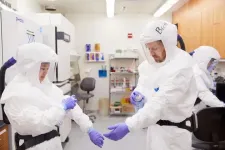(Press-News.org) COVID-19 therapies made from antibodies often are given to patients who are at high risk of severe illness and hospitalization. However, there have been nagging questions about whether such antibody therapies retain their effectiveness as worrisome new virus variants arise.
New research at Washington University School of Medicine in St. Louis suggests that many, but not all, therapies made from combinations of two antibodies are effective against a wide range of variants of the virus. Further, combination therapies appear to prevent the emergence of drug resistance.
The study, in mice and hamsters, tested all single and combination antibody-based therapies authorized for emergency use by the Food and Drug Administration (FDA), or that are being evaluated in late-stage clinical trials, against a panel of emerging international and U.S. variants of SARS-CoV-2, the virus that causes COVID-19.
The findings, published June 21 in the journal Nature, suggest that COVID-19 drugs made of two antibodies often retain potency as a therapy against variants even when in vitro studies -- experiments conducted in a dish -- indicate that one of the two antibodies has lost some or all ability to neutralize the variant.
"We knew how these antibodies were behaving in vitro, but we don't give people drugs based solely on cell culture data," said senior author Michael S. Diamond, MD, PhD, the Herbert S. Gasser Professor of Medicine. "When we looked in animals, there were some surprises. Some of the combinations performed better than we thought they would, based on in vitro data. And there was no drug resistance to combinations whatsoever, across all of the different variants. We're going to have to continue to monitor the effectiveness of antibody therapy as more variants arise, but combination therapy is likely needed for treating infections with this virus as more variants emerge."
So-called monoclonal antibodies mimic those generated by the body to fight off the virus that causes COVID-19. Administration of antibody therapies bypasses the body's slower and sometimes less effective process of making its own antibodies. At the time this study began, there were two dual-antibody combination therapies and a single antibody therapy authorized by the FDA for emergency use. The FDA withdrew authorization for the single antibody therapy, bamlanivimab, in April on the grounds that it was not effective against the variants circulating at that time. In May, the FDA authorized the single antibody sotrovimab as a treatment for COVID-19.
In all, the researchers evaluated antibodies corresponding to the FDA-authorized ones made by Eli Lilly and Co., Regeneron and Vir Biotechnology/GlaxoSmithKline, as well as the antibodies currently under development by AbbVie, Vir and AstraZeneca that are in clinical trials.
The researchers -- led by co-first authors Rita E. Chen, an MD/PhD student, Emma S. Winkler, an MD/PhD student, and Brett Case, PhD, a postdoctoral researcher -- tested the antibodies against a panel of virus variants containing key mutations in their spike genes. The SARS-CoV-2 virus uses spike protein to invade cells. All monoclonal antibody-based COVID-19 therapies work by interfering with the interaction between spike protein and cells.
The panel included mutations found in three of the four variants that have been designated "variants of concern" by the World Health Organization -- Alpha (first identified in the United Kingdom), Beta (South Africa) and Gamma (Brazil) -- as well as an emerging variant from India similar to the Delta variant of concern. They also tested variants from New York and California. The researchers used a mix of virus samples originally obtained from people with COVID-19 and laboratory strains genetically engineered to contain key mutations.
The researchers evaluated the antibodies in hamsters and two strains of mice. The researchers first gave the animals antibodies -- singly or in the same combinations in which they are given to treat patients -- a day before infecting them with one of the virus variants. The researchers monitored the animals' weight for six days and then measured the amount of virus in their noses, lungs and other parts of the body.
Although some single antibodies showed reduced or no ability to neutralize virus variants in a dish, low doses of most of the antibody combinations protected against disease caused by many of the variants. The researchers sequenced viral samples from the animals and found no evidence of drug resistance in viruses from any of the animals that had been treated with combination therapies.
"Dual therapy seemed to prevent the emergence of resistant viruses," said co-author Jacco Boon, PhD, an associate professor of medicine, of molecular microbiology and of pathology & immunology. "Resistance arose with some of the monotherapies, but never with combination therapy."
Since antibody-based COVID-19 therapies primarily are used to treat people who already are infected, the researchers also evaluated how well the antibody combinations performed when given after infection with the Beta variant. The Beta variant was chosen because it has been shown to be most likely to escape neutralization in laboratory-based experiments and has the most resistance to COVID-19 vaccines. The antibody cocktails corresponding to those from AstraZeneca, Regeneron and Vir were all effective at reducing disease caused by the Gamma variant; the one from AbbVie only was partially protective, and the one from Lilly showed no efficacy at all.
"It's going to be useful going forward to understand how these monoclonal antibodies are going to behave as variants continue to emerge," said Diamond, who also is a professor of molecular microbiology and of pathology & immunology. "We need to think about and generate combinations of antibodies to preserve our ability to treat this disease. And we'll need to monitor for resistance -- although, in my opinion, the use of specific combinations will make this less of an issue."
INFORMATION:
HOUSTON - (June 21, 2021) - Diamond may be just a phase carbon goes through when exposed to a flash of heat, but that makes it far easier to obtain.
The Rice University lab of chemist James Tour is now able to "evolve" carbon through phases that include valuable nanodiamond by tightly controlling the flash Joule heating process they developed 18 months ago.
Best of all, they can stop the process at will to get product they want.
In the American Chemical Society journal ACS Nano, the researchers led by Tour and graduate student and lead author Weiyin Chen show that adding organic fluorine compounds and ...
LAWRENCE -- Tulsa may not be the first town one thinks of when talking about jazz, and flood management may not be the first vocation one compares to the musical genre. But the success Tulsa displayed in going from one of the nation's most flood-prone cities to a nationally recognized model of long-term risk reduction in just two decades is analogous to the evolution of one of the most American styles of music, a University of Kansas professor points out in a new study.
Tulsa, the second-largest city in Oklahoma, suffered several devastating floods in the 1970s and 1980s, then became a national model for flood mitigation by the 1990s. What hasn't been studied closely is how a group of engineers, planners, government officials, journalists, attorneys and citizens came together ...
The word "tsunami" brings immediately to mind the havoc that can be wrought by these uniquely powerful waves. The tsunamis we hear about most often are caused by undersea earthquakes, and the waves they generate can travel at speeds of up to 250 miles per hour and reach tens of meters high when they make landfall and break. They can cause massive flooding and rapid widespread devastation in coastal areas, as happened in Southeast Asia in 2004 and in Japan in 2011.
But significant tsunamis can be caused by other events as well. The partial collapse of the volcano Anak Krakatau in Indonesia in 2018 caused a tsunami that killed more than 400 people. Large landslides, which send immense amounts of debris into the sea, also ...
Following fertilization, early plant embryos arise through a rapid initial diversification of their component cell types. As a result, this series of coordinated cell divisions rapidly sculpts the embryo's body plan. The developmental phenomenon in question is orchestrated by a transcriptional activation of the plant genome. However, the underlying cellular differentiation programs have long remained obscured as the plant embryos were hard to isolate. In fact, previous attempts at creating datasets of the plant embryonic differentiation programs were incapable ...
A commonly studied perovskite can superfluoresce at temperatures that are practical to achieve and at timescales long enough to make it potentially useful in quantum computing applications. The finding from North Carolina State University researchers also indicates that superfluorescence may be a common characteristic for this entire class of materials.
Superfluorescence is an example of quantum phase transition - when individual atoms within a material all move through the same phases in tandem, becoming a synchronized unit.
For example, when atoms in an optical material such as a perovskite are excited they can individually radiate light, create energy, and fluoresce. Each atom will start moving through these phases randomly, but given the right conditions, they can synchronize in ...
All plant cells obtain their energy mainly from two organelles they contain - chloroplasts (responsible for photosynthesis) and mitochondria (responsible for the biochemical cycle of respiration that converts sugars into energy). However, a large number of a plant cell's genes in its mitochondria and chloroplasts can develop defects, jeopardising their function. Nevertheless, plant cells evolved an amazing tool called the RNA editosome (a large protein complex) to repair these kinds of errors. It can modify defective messenger RNA that result from defective DNA by transforming (deamination) of certain mRNA nucleotides.
Automatic error correction in plant cells
Automatic error correction in plants was discovered about 30 years ago by a team headed by plant physiologist Axel Brennicke ...
While the LGBTQ+ community has seen significant advancements in legal rights, political representation and social acceptance over recent years, mental and physical health disparities still exist for queer Americans - and are even worse among younger generations, says a new study from Michigan State University.
In the first-ever population-based national study comparing mental and physical health of lesbian, gay and bisexual (LGB) Americans to their straight counterparts, MSU sociologist Hui Liu and research partner Rin Reczek, professor of sociology from Ohio State University, found that when compared to their straight counterparts, LGB Millennials have worse health disadvantages than their older peers, though disparities persist throughout older generations as ...
All coronaviruses produce four primary structural proteins and multiple nonstructural proteins. However, the majority of antibody-based SARS-CoV-2 research has focused on the spike and nucleocapsid proteins. A study published in PLOS Biology by Anna Heffron, Irene Ong and colleagues at the University of Wisconsin-Madison, USA, suggests that immune responses may develop against other proteins produced by the SARS-CoV-2 virus.
The efficacy of spike protein-based vaccines is variable and not everyone infected with SARS-CoV-2 produces detectable antibodies against the spike or ...
In a new study published today in the American Journal of Human Genetics, researchers announced the development of a new method to increase the utility and equity of large genetic databases. The research was conducted by Audrey Hendricks, an associate professor of statistics at the University of Colorado Denver (CU Denver).
Summix, the new method developed by Hendricks and her team of CU Denver undergraduate and graduate students, estimates the genetic ancestry in databases and adjusts the information to match the ancestry of a person or sample of people. This method leads large genetic databases to become more useful for people of various ancestries such as African American or Latinx, as they are underrepresented in genetic ...
Every day, our bodies face a bombardment of UV rays, ozone, cigarette smoke, industrial chemicals and other hazards.
This exposure can lead to free-radical production in our bodies, which damages our DNA and tissues. A new study from West Virginia University researcher Eric E. Kelley--in collaboration with the University of Minnesota--suggests that unrepaired DNA damage can increase the speed of aging.
The study appears in the journal Nature.
Kelley and his team created genetically-modified mice with a crucial DNA-repair protein missing from their hematopoietic stem cells, immature immune cells that develop into white blood cells. Without this ...



